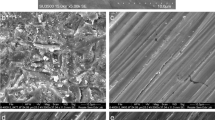Abstract
Up to now, there is no any experience about the application of dental lasers to bond resin composites to metal surfaces in dentistry. The aim of this preliminary study was to evaluate if the laser irradiation of ceramic-covered alloy surface would improve the bond strength of resin to metal, and if different parameters of laser output may influence the strength of this bond. Fifty three cylinders (thickness of 5 mm and diameter of 10 mm) were made up of a commercially available nickel–chromium alloy by lost-wax technique. Forty prepared specimens were divided into four groups. Five specimens in each group were covered by slurry of dental opaque porcelain and irradiated by Nd:YAG laser using different output parameters for each group. Other five specimens in each group were treated using the same laser parameters without porcelain covering. Five sandblasted specimen served as control group. Panavia F2.0 was bonded on the metal surfaces using polyethylene tubes. In ceramic-coated specimens, silane was applied to achieve chemical bond between silica particles and resin cement. All specimens were thermocycled and subjected to shear bond strength (SBS) test (50 kgf at 0.5 mm/min). Two specimens of each ceramic-coated laser-treated groups were studied using scanning electron microscopy and wavelength dispersive X-ray spectroscopy which showed stabilization of silica particles on the metal surface. ANOVA procedure showed that although shear bond strength was significantly higher in porcelain-covered laser treated samples, but the effect of power output of laser irradiation was not significant (P = 0.917). There were no statistically significant difference between SBS in control samples and laser treated specimens without porcelain covering. It can be concluded that Nd:YAG laser surface treatment may improve the silica coating of alloy surface to achieve better resin–metal bond.



Similar content being viewed by others
References
dos Santos JG, Fonseca RG, Adabo GL, dos Santos Cruz CA (2006) Shear bond strength of metal-ceramic repair systems. J Prosthet Dent 96(3):165–173
Haselton DR, Diaz-Arnold AM, Dunne JT Jr (2001) Shear bond strengths of 2 intraoral porcelain repair systems to porcelain or metal substrates. J Prosthet Dent 86(5):526–531
Ozcan M (2003) Evaluation of alternative intra-oral repair techniques for fractured ceramic-fused-to-metal restorations. J Oral Rehabil 30(2):194–203
Kern M, Thompson VP (1993) Sandblasting and silica-coating of dental alloys: volume loss, morphology and changes in the surface composition. Dent Mater 9(3):151–161
Chung KH, Hwang YC (1997) Bonding strengths of porcelain repair systems with various surface treatments. J Prosthet Dent 78(3):267–274
Pameijer CH, Louw NP, Fischer D (1996) Repairing fractured porcelain: how surface preparation affects shear force resistance. J Am Dent Assoc 127(2):203–209
Yanagida H, Matsumura H, Atsuta M (2001) Bonding of prosthetic composite material to Ti-6Al-7Nb alloy with eight metal conditioners and a surface modification technique. Am J Dent 14(5):291–294
Matsumura H, Tanaka T, Taira Y, Atsuta M (1996) Bonding of a cobalt-chromium alloy with acidic primers and tri-n-butylborane-initiated luting agents. J Prosthet Dent 76(2):194–199
Shahverdi S, Canay S, Sahin E, Bilge A (1998) Effects of different surface treatment methods on the bond strength of composite resin to porcelain. J Oral Rehabil 25(9):699–705
Paranhos MP, Burnett LH Jr, Magne P (2011) Effect Of Nd:YAG laser and CO2 laser treatment on the resin bond strength to zirconia ceramic. Quintessence Int 42(1):79–89
da Silva Ferreira S, Hanashiro FS, de Souza-Zaroni WC, Turbino ML, Youssef MN (2010) Influence of aluminum oxide sandblasting associated with Nd:YAG or Er:YAG lasers on shear bond strength of a feldspathic ceramic to resin cements. Photomed Laser Surg 28(4):471–475
Petridis H, Garefis P, Hirayama H, Kafantaris NM, Koidis PT (2003) Bonding indirect resin composites to metal. Part 1. Comparison of shear bond strengths between different metal-resin bonding systems and a metal-ceramic system. Int J Prosthodont 16(6):635–639
Haneda IG, Fonseca RG, de Almeida JG, Cruz CA, Adabo GL (2009) Shear bond strength of metal-ceramic repair systems. Gen Dent 57(6):644–651, quiz 52-3, 595, 680
Guggenberger R (1989) Rocatec system–adhesion by tribochemical coating. Dtsch Zahnarztl Z 44(11):874–876
Zupancic R, Legat A, Funduk N (2006) Tensile strength and corrosion resistance of brazed and laser-welded cobalt-chromium alloy joints. J Prosthet Dent 96(4):273–282. doi:10.1016/j.prosdent.2006.08.006
Draper CW, Poate JM (1985) Laser surface alloying. Int Met Rev 30(1):85–108
Fonseca RG, de Almeida JG, Haneda IG, Adabo GL (2009) Effect of metal primers on bond strength of resin cements to base metals. J Prosthet Dent 101(4):262–268
Sarafianou A, Seimenis I, Papadopoulos T (2008) Effectiveness of different adhesive primers on the bond strength between an indirect composite resin and a base metal alloy. J Prosthet Dent 99(5):377–387
Almilhatti HJ, Giampaolo ET, Vergani CE, Machado AL, Pavarina AC, Betiol EA (2009) Adhesive bonding of resin composite to various Ni–Cr alloy surfaces using different metal conditioners and a surface modification system. J Prosthodont 18(8):663–669
Ishii T, Koizumi H, Yoneyama T, Tanoue N, Ishikawa Y, Matsumura H (2008) Comparative evaluation of thione and phosphate monomers on bonding gold alloy and Ti-6Al-7Nb alloy with tri-n-butylborane initiated resin. Dent Mater J 27(1):56–60
Yoshida K, Taira Y, Matsumura H, Atsuta M (1993) Effect of adhesive metal primers on bonding a prosthetic composite resin to metals. J Prosthet Dent 69(4):357–362
Watkins KG, McMahon MA, Steen WM (1997) Microstructure and corrosion properties of laser surface processed aluminium alloys: a review. Mater Sci Eng A 231(1-2):55–61. doi:10.1016/S0921-5093(97)00034-8
Kunt GE, Guler AU, Ceylan G, Duran I, Ozkan P, Kirtiloglu T (2012) Effects of Er:YAG laser treatments on surface roughness of base metal alloys. Lasers Med Sci 27(1):47–51
Acknowledgments
This study was supported by a grant from the Vice Chancellor of Research of Mashhad University of Medical Sciences.
Author information
Authors and Affiliations
Corresponding author
Rights and permissions
About this article
Cite this article
sadat Madani, A., Astaneh, P.A., Shahabi, S. et al. Influence of different power outputs of intraoral Nd:YAG laser on shear bond strength of a resin cement to nickel–chromium dental alloy. Lasers Med Sci 28, 229–234 (2013). https://doi.org/10.1007/s10103-012-1095-2
Received:
Accepted:
Published:
Issue Date:
DOI: https://doi.org/10.1007/s10103-012-1095-2




